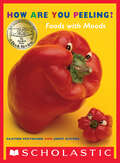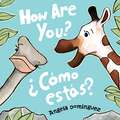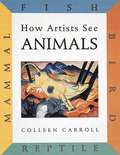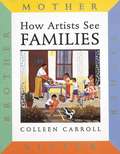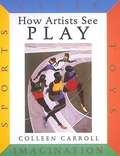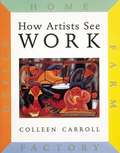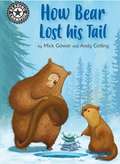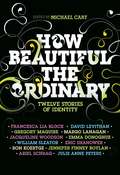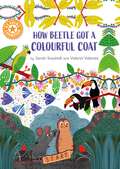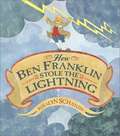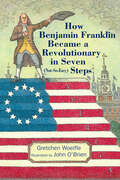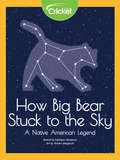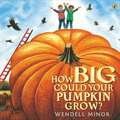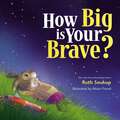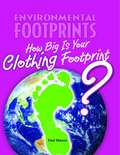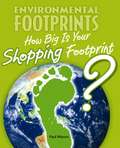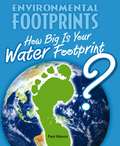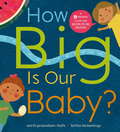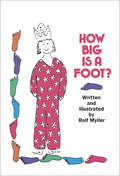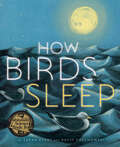- Table View
- List View
How Are You Peeling? (Scholastic Bookshelf)
by Saxton Freymann Joost ElffersLet Scholastic Bookshelf be your guide through the whole range of your child's experiences-laugh with them, learn with them, read with them! Eight classic, best-selling titles are available now!Category: Feelings"Amused? Confused? Frustrated? Surprised? Try these feelings on for size."This is a book that asks all the right questions. And leaves you feeling great no matter what the answers are!"Who'd have dreamed that produce could be so expressive, so charming, so lively and so funny?...Freymann and...Elffers have created sweet and feisty little beings with feelings, passions, fears and an emotional range that is, well, organic."-The New York Times Book Review
How Are You, Verity?
by Meghan Wilson DuffA neurodivergent child interacts with their neighbors to discover the true meaning behind greetings and salutations. When people say &“How are you?&” are they really asking or just saying hello? Verity, who is neurodivergent, plans an experiment to figure this out. Verity is bubbling with excitement about an upcoming school field trip to the aquarium! When neighbors ask, &“How are you?&” Verity shares their excitement and fascinating facts about sea animals. Their older brother John kindly suggests that the question "How are you?" is actually a greeting and not an invitation to share so much. Verity plans an experiment to find out if their brother is right. But when the trip to the aquarium is cancelled, Verity is heartbroken. When people ask &“How are you?&” what should they say then?
How Are You? / ¿Cómo estás? (Spanish bilingual)
by Angela DominguezFriendship awaits in this bilingual book about feelings, How Are You? / ¿Cómo estás? by Angela Dominguez-- expressed both in English and in Spanish.When two giraffe friends find a baby ostrich, they have some questions. Is baby ostrich hungry? Shy? Tired? Ostrich says no! So how does she feel?
How Artists See Animals: Mammal, Fish, Bird, Reptile
by Colleen CarrollExamines how different kinds of animals have been depicted in works of art from different time periods and places.
How Artists See FAMILIES: Mother, Father, Sister, Brother
by Colleen CarrollExamines how families have been depicted in works of art from different time periods and places.
How Artists See Play: Sports Games Toys Imagination
by Colleen CarrollExamines how sports, games, toys, and other aspects of play have been depicted in works of art from different time periods and places.
How Artists See Work: Farm, Factory, Home, Office
by Colleen CarrollExamines how people have been depicted working on farms, in factories and offices, and at home in works of art from different times and places.
How Bear Lost His Tail: Independent Reading 11 (Reading Champion #298)
by Mick GowarA fun retelling of this Native American legend. Bear is tricked by Otter into fishing with his beautiful, long tail - and it ends up getting frozen and snapping off!Reading Champion offers independent reading books for children to practise and reinforce their developing reading skills.Fantastic, original stories are accompanied by engaging artwork and a reading activity. Each book has been carefully graded so that it can be matched to a child's reading ability, encouraging reading for pleasure.The Key Stage 2 Reading Champion Books are suggested for use as follows:Independent Reading 11: start of Year 3 or age 7+Independent Reading 12: end of Year 3 or age 7+Independent Reading 13: start of Year 4 or age 8+Independent Reading 14: end of Year 4 or age 8+Independent Reading 15: start of Year 5 or age 9+Independent Reading 16: end of Year 5 or age 9+Independent Reading 17: start of Year 6 or age 10+Independent Reading 18: end of Year 6 or age 10+
How Beautiful the Ordinary: Twelve Stories of Identity
by Emma Donoghue Ron Koertge Julie Anne Peters David Levithan Francesca Lia Block Michael Cart Jennifer Finney Boylan Eric Shanower William SleaterA girl thought to be a boy steals her sister's skirt, while a boy thought to be a girl refuses to wear a cornflower blue dress. One boy's love of a soldier leads to the death of a stranger. The present takes a bittersweet journey into the past when a man revisits the summer school where he had "an accidental romance." And a forgotten mother writes a poignant letter to the teenage daughter she hasn't seen for fourteen years. Poised between the past and the future are the stories of now. In nontraditional narratives, short stories, and brief graphics, tales of anticipation and regret, eagerness and confusion present distinctively modern views of love, sexuality, and gender identification. Together, they reflect the vibrant possibilities available for young people learning to love others--and themselves--in today's multifaceted and quickly changing world.
How Beetle got its Colourful Coat: Independent Reading Orange 6 (Reading Champion #1076)
by Sarah SnashallThis story is part of Reading Champion, a series carefully linked to book bands to encourage independent reading skills, developed with Dr Sue Bodman and Glen Franklin of UCL Institute of Education (IOE)Reading Champion offers independent reading books for children to practise and reinforce their developing reading skills.Fantastic, original stories are accompanied by engaging artwork and a reading activity. Each book has been carefully graded so that it can be matched to a child's reading ability, encouraging reading for pleasure. Perfect for 5-7 year olds or those reading book band orange.
How Ben Franklin Stole the Lightning
by Rosalyn SchanzerBen Franklin was the most famous American in the entire world during colonial times. No wonder! After all, the man could do just about anything. Why, he was an author and an athlete and a patriot and a scientist and an inventor to boot. He even found a way to steal the lightning right out of the sky.<P><P> Is such a thing possible? Is it. Take a look inside and find Ben busy at work on every spread. Then find out how he used his discovery about lightning to make people's lives safer.<P> In an inventive way, Rosalyn Schanzer brings us a brilliant and ever-curious American original.
How Benjamin Franklin Became a Revolutionary in Seven (Not-So-Easy) Steps
by Gretchen WoelfleHow did Ben Franklin become an outspoken leader of the American Revolution? Learn all about it in seven (not-so-easy) steps in this humorous, accessible middle-grade chapter book that focuses on Ben&’s political awakening.Famous founding father Benjamin Franklin was a proud subject of the British Empire—until he wasn&’t. It took nearly seventy years and seven not-so-easy steps to turn Benjamin Franklin from a loyal British subject to a British traitor—and a fired-up American revolutionary. In this light, whimsical narrative, young readers learn how Franklin came to be a rebel, beginning with his childhood lesson in street smarts when he buys a whistle at an inflated price. Franklin is a defiant boy who runs away from his apprenticeship, and while he becomes a deep thinker, a brilliant scientist, and a persuasive writer when he grows up, he never loses that spark. As a community leader who tries his best to promote peace and unity both between the colonies and with Great Britain, he becomes more and more convinced that independence for the American colonies is the way forward.Illustrated throughout with art by noted New Yorker cartoonist and illustrator John O&’Brien and sprinkled with quotations from Franklin, this unfamiliar story of a familiar figure in American history will surprise and delight young readers.
How Bicycles Changed the World / Young Bike Racers (Fountas & Pinnell Classroom, Guided Reading Grade 4)
by Michael SandlerNIMAC-sourced textbook
How Big Bear Stuck to the Sky
by Kathleen MuldoonOne of the most well-known constellations in the night sky, the Big Dipper, traces its origins to a Native American legend. Many animals attempted to break through Sky in order to spread light and warmth onto the Earth. Only one of them, a Great Bear—also known as Ursa Major—succeeds. How does Great Spirit reward him?
How Big Could Your Pumpkin Grow?
by Wendell MinorEvery year, giant pumpkin contests take place at fairs across the country—the 2012 record-holder weighed over a ton! The latest craze is to carve the most enormous pumpkins into racing boats. But what&’s next? Why not think really big? Award-winning artist Wendell Minor does just that as he imagines larger-than-life pumpkins decorating some of America&’s favorite places—as immense as the Capitol dome, Mount Rushmore, the Brooklyn Bridge, even the Grand Canyon! This celebration of famous landmarks and landscapes plays with concepts of size and scale and is full of fun facts.
How Big Is It? A Big Book All About Bigness
by Ben HillmanWHAT'S THE BIG IDEA HOW BIG IS IT? A BIG Book All About BIGNESS How tall is a giraffe? 17.3 feet . . . or . . . If one was standing in your living room, you'd have to cut a hole in the ceiling, and its head would reach the top of a second-floor bedroom! Learn about big things like pyramids, diamonds in the sky, giant spiders, snakes, birds, flowers and more!
How Big Is Your Brave?
by Ruth SoukupHow do you teach a child to dream big and shoot for the stars? In this inspiring story, a young bunny named Zippy dreams of traveling to space. When the opportunity to attend space camp arrives, she worries she might not be capable enough to compete with other kids. But Zippy&’s desire to build her rocket is bigger than her fear of failing, and through hard work and creativity works to make her dreams come true.New York Times bestselling author Ruth Soukup empowers children everywhere to dream big and live a life they love. How Big Is Your Brave? encourages readers to face their fears and overcome obstacles in order to follow their dreams and reach their goals.How Big Is Your Brave? is:Great for boys and girls, ages 4–8An excellent choice for STEM storytime and sparking discussions about STEM fieldsA great resource to teach young children about confidence, self-esteem, and the value of hard workThrough whimsical illustrations and encouraging text, children will discover how standing up to fears (both big and small) makes them stronger and unstoppable.
How Big Is Your Clothing Footprint? (Environmental Footprints)
by Paul MasonWhat sort of footprint are you leaving on the environment? Do you have a heavy footprint or a light footprint? Everything we do and everything we use has an impact on the environment. Heavy footprints harm the environment and use lots of natural resources. Light footprints harm the environment as little as possible and use fewer natural resources. Read the ENVIRONMENTAL FOOTPRINTS series to decide what type of footsteps you want to take in the future! In How Big Is Your Clothing Footprint? read about what makes up a clothing footprint and the effect this has on the environment. Discover ways to reduce your clothing footprint and live sustainably. Special Features: Rethink! feature offers ways to lighten your footprints Case Studies give real-life examples of heavy-footprint and light-footprint actions. Rethink! Repairing clothes makes them last longer. Repairing instead of replacing clothing means a lighter footprint on the environment. How Big Is Your Clothing Footprint? How Big Is Your Energy Footprint? How Big Is Your Food Footprint? How Big Is Your Shopping Footprint? How Big Is Your Travel Footprint? How Big Is Your Water Footprint?
How Big Is Your Energy Footprint? (Environmental Footprints)
by Paul MasonWhat sort of footprint are you leaving on the environment? Do you have a heavy footprint or a light footprint? Everything we do and everything we use has an impact on the environment. * Heavy footprints harm the environment and use lots of natural resources. * Light footprints harm the environment as little as possible and use fewer natural resources. Read the ENVIRONMENTAL FOOTPRINTS series to decide what type of footsteps you want to take in the future! In How Big Is Your Energy Footprint? read about what makes up an energy footprint and the effect this has on the environment. Discover ways to reduce your energy footprint and live sustainably. Special Features Rethink! feature offers ways to lighten your footprints. Case Studies give real-life examples of heavy-footprint and light-footprint actions. How Big Is Your Clothing Footprint? How Big Is Your Energy Footprint? How Big Is Your Food Footprint? How Big Is Your Shopping Footprint? How Big Is Your Travel Footprint? How Big Is Your Water Footprint?
How Big Is Your Shopping Footprint? (Environmental Footprints)
by Paul MasonWhat sort of footprint are you leaving on the environment? Do you have a heavy footprint or a light footprint? Everything we do and everything we use has an impact on the environment. Heavy footprints harm the environment and use lots of natural resources. Light footprints harm the environment as little as possible and use fewer natural resources. Read the ENVIRONMENTAL FOOTPRINTS series to decide what type of footsteps you want to take in the future! In How Big Is Your Shopping Footprint? read about what makes up a shopping footprint and the effect this has on the environment. Discover ways to reduce your shopping footprint and live sustainably. Special Features Rethink! feature offers way to lighten your footprints Case studies give real-life examples of heavy-footprint and light-footprint actions. Rethink! Disposable plastic shopping bags create waste. Bringing reusable canvas bags to hold your purchases at the mall or grocery store lowers your shopping footprint.
How Big Is Your Water Footprint? (Environmental Footprints)
by Paul MasonWhat sort of footprint are you leaving on the environment? Do you have a heavy footprint or a light footprint? Everything we do and everything we use has an impact on the environment. Heavy footprints harm the environment and use lots of natural resources. Light footprints harm the environment as little as possible and use fewer natural resources. In How Big Is Your Water Footprint? read about what makes up a water footprint and the effect this has on the environment. Discover ways to reduce your water footprint and live sustainably. Special features: Rethink! feature offers ways to lighten your footprints. Case studies give real-life examples of heavy-footprint and light-footprint actions.
How Big is Our Baby?: A 9-month guide for soon-to-be siblings
by Smriti Prasadam-HallsWhen a new baby is on the way, siblings-to-be have lots of feelings and plenty of questions. But whether they're impatient, curious or a little worried, this friendly and reassuring guide explains each step of the pregnancy journey and helps little ones feel involved and excited. With a month-by-month approach that compares the size of the growing baby to something familiar to the young reader, such as a speck of sand at the seaside or an egg, readers also find out about how Baby is developing, from when the heart might first beat to when they'll be able to feel it kick. The book also includes information about how life might change once Baby arrives, and how exciting it will be to have a new baby brother or sister.
How Big is a Foot?
by Rolf MyllerWith the Queen's birthday only days away, the King is concerned that the royal carpenters will not be able to build her a bed because they do not know how to measure.
How Birds Sleep
by David ObuchowskiDiscover the mysterious and fascinating sleeping habits of more than twenty bird species from around the world in this gorgeously illustrated read-aloud picture book, perfect for bedtime, or any time.Have you ever seen a bird sleep? Or wondered just when it is that migrating cranes find the time to catch Z&’s as they cross the ocean? From the parrots of Thailand to the ostriches of Australia and even the pigeons of New York City, every bird sleeps—but they do it in ways that will surprise and delight you. Some hang from tree branches, others doze while gliding, and some even burrow underground for a nap. Written in a witty, conversational voice, and with gorgeous illustrations, this picture book is bursting with interesting facts about this underexplored aspect of bird life all around us.
